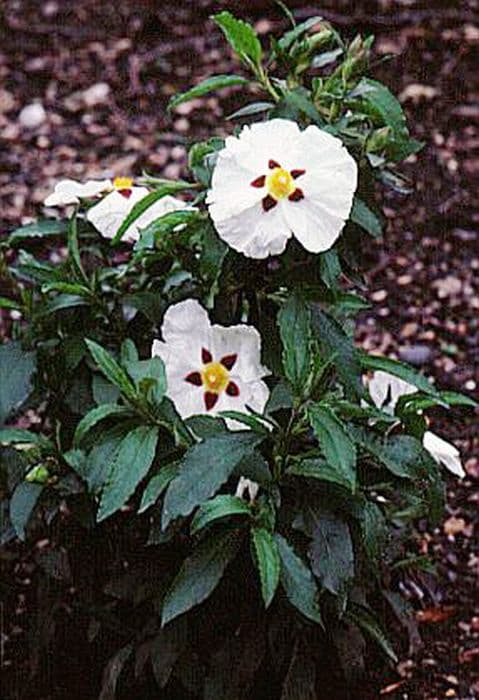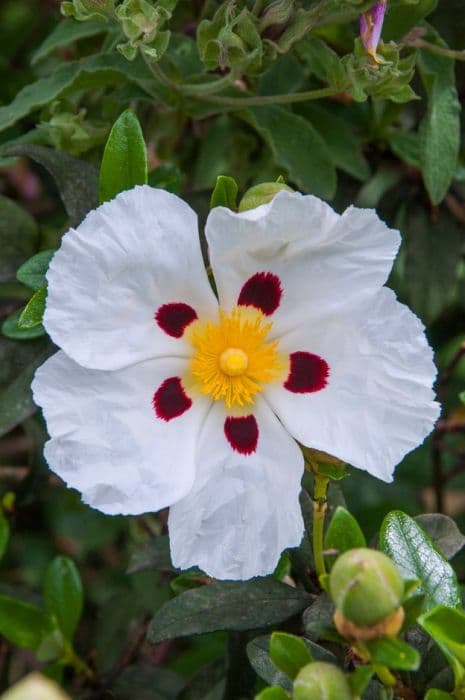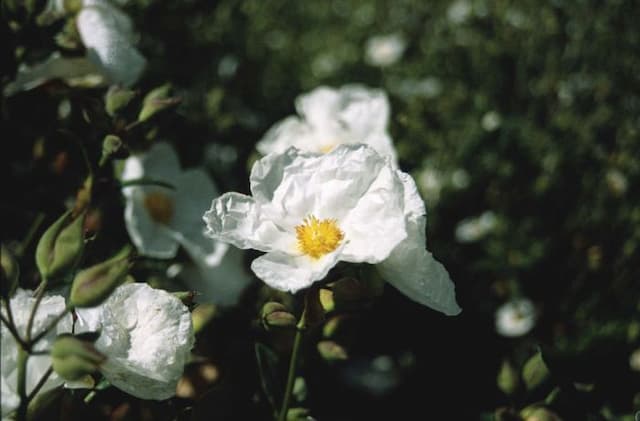Rock Rose Helianthemum 'Amy Baring'

ABOUT
The plant known as 'Amy Baring' has a striking appearance, characterized by its vibrant flowers and rich foliage. The blooms are particularly eye-catching, with their distinct yellow-orange hue that can add a splash of sunlight to any garden. Resembling miniature roses, the flowers are composed of numerous delicate petals that form a cup-like shape, emerging in abundance to create a showy display that can attract pollinators. Contrasting with the warm tones of the blossoms, the foliage provides a lush, green backdrop. The leaves are small, with a slightly leathery texture, and they often exhibit a grey-green color which may sometimes carry a silvery sheen, giving the plant a soft, velvety look. The overall bushy and mounding habit makes it an excellent choice for ground cover, border fronts, or rock gardens, where its bursts of color and textured leaves can be appreciated up close.
About this plant
 Names
NamesFamily
Cistaceae
Synonyms
Rock Rose, Sunrose
Common names
Helianthemum 'Amy Baring'.
 Toxicity
ToxicityTo humans
Rock Rose is generally considered non-toxic to humans. There are no known toxic effects from ingesting this plant, and no symptoms of poisoning associated with it are documented. However, as with any plant, individual allergies or sensitivities could potentially cause mild reactions in some people.
To pets
Rock Rose is also generally considered non-toxic to pets. There are no significant toxic effects expected if pets ingest this plant. It does not contain any known toxic compounds that would typically lead to poisoning in animals such as dogs or cats. However, the consumption of any plant material may cause gastrointestinal upset in some pets, which could include symptoms like vomiting or diarrhea.
 Characteristics
CharacteristicsLife cycle
Perennials
Foliage type
Evergreen
Color of leaves
Green
Flower color
Yellow
Height
1 foot (0.3 meters)
Spread
2 feet (0.6 meters)
Plant type
Shrub
Hardiness zones
5
Native area
Mediterranean
Benefits
 General Benefits
General Benefits- Low Maintenance: Helianthemum 'Amy Baring', commonly known as rock rose, requires minimal care once established.
- Drought Tolerant: Rock rose is highly drought-resistant, making it suitable for arid or water-restricted gardens.
- Attracts Pollinators: With its vibrant flowers, it attracts bees, butterflies, and other beneficial pollinators.
- Ground Cover: The low-growing habit makes it an excellent choice for ground cover, reducing soil erosion.
- Ornamental Value: Adds visual interest to gardens with its cheerful, colorful blooms that last throughout the spring and summer.
- Sun Loving: Thrives in full sun, perfect for sunny garden spots where other plants might struggle.
- Deer Resistant: Its foliage and flowers are typically not favored by deer, making it a good choice for deer-prone areas.
- Versatile: Suitable for rock gardens, borders, and containers, providing flexibility in garden design.
- Evergreen: Some varieties are evergreen, providing year-round interest in the garden.
 Medical Properties
Medical PropertiesThis plant is not used for medical purposes.
 Air-purifying Qualities
Air-purifying QualitiesThis plant is not specifically known for air purifying qualities.
 Other Uses
Other Uses- The Rock Rose 'Amy Baring' can be used as a natural dye for fabrics, providing a range of colors from yellow to orange depending on the mordant used.
- Dried petals of the Rock Rose can be incorporated into candles to add a subtle fragrance and aesthetic appeal.
- The plant can be used in potpourri mixes for its delicate scent and decorative petals, enhancing the visual and olfactory ambiance of a room.
- Rock Rose petals can be pressed and used in crafting, such as making bookmarks, greeting cards, or in scrapbooking for their beauty and texture.
- When dried, the branches can be used in floral arrangements to provide structure and a touch of wilderness to the composition.
- Leaves of the Rock Rose can be used as a natural insect repellent when crushed and applied to the skin or used in sachets to ward off moths from closets.
- The Rock Rose can be utilized in the creation of eco-friendly confetti, as the petals are biodegradable and less harmful to the environment than plastic confetti.
- Rock Rose plants can be used in garden design to create a natural rockery landscape, contributing to biodiversity and offering shelter to beneficial insects.
- Landscape artists can use the Rock Rose for bonsai due to its resilience and adaptability to pruning and shaping.
- The plant's fibrous stems can be repurposed into a rough twine or cord for garden use, for activities such as staking other plants.
Interesting Facts
 Feng Shui
Feng ShuiThe Rock Rose is not used in Feng Shui practice.
 Zodiac Sign Compitability
Zodiac Sign CompitabilityThe Rock Rose is not used in astrology practice.
 Plant Symbolism
Plant Symbolism- Endurance and Survival: The Helianthemum, commonly known as Rock Rose, is renowned for its ability to thrive in rocky, arid conditions, symbolizing resilience and the strength to endure life's challenges.
- Beauty and Radiance: With its vibrant flowers, the Rock Rose symbolizes beauty, brightness, and a positive outlook, representing an ability to shine despite adversities.
- Renewal and Hope: The persistent blooming of the Rock Rose is often seen as a sign of new beginnings and hope, encouraging one to look forward to the future with optimism.
 Water
WaterRock Rose (Helianthemum 'Amy Baring') prefers moderate watering, needing enough to keep the soil slightly moist but never waterlogged. In the growing season, watering once a week with approximately half a gallon per plant should suffice, depending on weather conditions. Allow the top inch of soil to dry out before watering again. During the winter, reduce watering to every two weeks or less, ensuring the soil does not remain wet for prolonged periods to prevent root rot.
 Light
LightRock Rose thrives in full sun exposure, requiring at least six hours of direct sunlight daily for optimal growth and flowering. The best spot for the plant is an area with unobstructed access to sunlight, avoiding places where buildings or trees significantly shade it during the day.
 Temperature
TemperatureRock Rose can tolerate a wide range of temperatures, but it performs best in temps between 60 and 80 degrees Fahrenheit. It can survive minimum temperatures down to around 20 degrees Fahrenheit, but frost and prolonged cold can be detrimental. Ensure to protect the plant from extreme cold by providing shelter or bringing it indoors if grown in a container.
 Pruning
PruningRegular pruning helps maintain the Rock Rose's shape and encourages bushier growth. Prune the plant lightly in early spring after the last frost and again after the flowering period to remove spent blooms and any dead or overgrown branches. The best time for hard pruning is late winter or early spring before new growth starts.
 Cleaning
CleaningAs needed
 Soil
SoilRock Rose 'Amy Baring' thrives best in well-draining, gritty soil with a slightly alkaline to neutral pH, typically between 6.5 to 7.5. A premium cactus mix amended with additional perlite or coarse sand helps ensure the right texture and drainage.
 Repotting
RepottingRock Rose 'Amy Baring' is generally repotted every two to three years or when it outgrows its current container. Spring is the ideal time for repotting to give the plant time to establish before winter.
 Humidity & Misting
Humidity & MistingRock Rose 'Amy Baring' prefers dry to average humidity levels and does not require high humidity; typical room humidity is usually sufficient for this plant.
 Suitable locations
Suitable locationsIndoor
Ensure bright light, minimal watering, and well-draining soil.
Outdoor
Plant in full sun, well-drained soil, and water sparingly.
Hardiness zone
5-8 USDA
 Life cycle
Life cycleThe Rock Rose 'Amy Baring' begins its life cycle as a seed, typically sown in the spring or fall, where it requires well-drained soil and some exposure to sunlight to germinate successfully. After germination, the seedling grows into a small plant, developing a woody base and green foliage, reaching maturity within a few months to a couple of years. As a mature plant, it produces vivid yellow flowers that bloom from late spring to early summer, attracting pollinators and facilitating cross-pollination. After pollination, the flowers fade and the plant produces small dry fruits containing seeds that are dispersed by wind or animal activity. The Rock Rose 'Amy Baring' is a perennial, so after blooming it typically enters a period of dormancy in the winter, with its foliage dying back and the plant surviving on stored energy in its root system. In subsequent years, the plant resprouts from the base, repeating the flowering cycle and potentially spreading its seeds to propagate new plants.
 Propogation
PropogationPropogation time
Spring-Early Summer
The Rock Rose 'Amy Baring', scientifically known as Helianthemum 'Amy Baring', is most commonly propagated through semi-hardwood cuttings. This method involves taking cuttings from the plant during the late summer when new growth has begun to mature and semi-harden. Cut a 4 to 6-inch (10 to 15 cm) length of stem, ensuring that a few leaves remain at the top. Strip the lower leaves and dip the cut end in rooting hormone to promote root development. Plant the cutting in a well-draining soil mix and keep it in a warm place with indirect light, ensuring the soil remains moist but not waterlogged. The cutting will typically root within several weeks, after which it can be gradually acclimated to outdoor conditions before transplanting.









